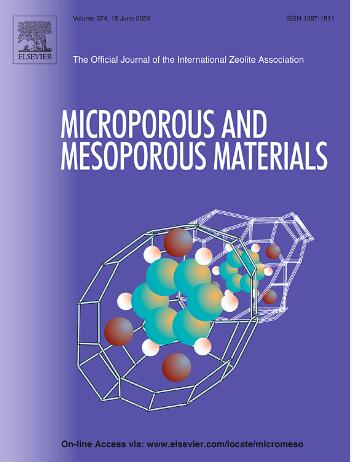Construction of PAC@Zeolite@GO composite with high adsorption capacity and environmentally friendly for defluoridation by synergistic effects
IF 4.8
3区 材料科学
Q1 CHEMISTRY, APPLIED
引用次数: 0
Abstract
Toxic fluoride-containing industrial wastewater discharged from rare earth mining, coal, and metallurgical industries has been considered as one of the major problems threatening human health. Seeking ultra-high adsorption capacity, low secondary pollution and low-cost fluoride adsorption technologies from wastewater has been the goal of environmental remediation. In this study, based on a photo-catalytic reduction reaction, the polyaluminum chloride (PAC) and graphene oxide (GO) co-modified zeolite (PAC@Zeolite@GO composite) were synthesized for efficiently removing fluoride from wastewater. Under optimal conditions (pH = 3, t = 240 min, T = 298 K, m = 25 mg L−1, C0 = 450 mg L−1), the adsorption capacity of PAC@Zeolite@GO composite toward fluoride was as high as ∼1264 mg g−1. Even after 3 times of recycling, the adsorption capacity could still reach 978.3 mg g−1. The fitting results of kinetics, isotherm and thermodynamics indicated that the adsorption process is an endothermic one, complies with the Langmuir isothermal adsorption and the pseudo-second-order kinetic model. The residual F− after PAC@Zeolite@GO composite adsorption and dissolved Al3+ were as low as 0.69 mg L−1 and 0.09 mg L−1, which reached the drinking water standard. The prominent adsorption ability of PAC@Zeolite@GO composite was attributed to electrostatic adsorption, ion exchange, hydrogen bond and complexation reactions. Based on their efficient performance, the PAC@Zeolite@GO composite is expected to be an effective and environmentally friendly, low-cost adsorbent for the defluorination of wastewater.

求助全文
约1分钟内获得全文
求助全文
来源期刊

Microporous and Mesoporous Materials
化学-材料科学:综合
CiteScore
10.70
自引率
5.80%
发文量
649
审稿时长
26 days
期刊介绍:
Microporous and Mesoporous Materials covers novel and significant aspects of porous solids classified as either microporous (pore size up to 2 nm) or mesoporous (pore size 2 to 50 nm). The porosity should have a specific impact on the material properties or application. Typical examples are zeolites and zeolite-like materials, pillared materials, clathrasils and clathrates, carbon molecular sieves, ordered mesoporous materials, organic/inorganic porous hybrid materials, or porous metal oxides. Both natural and synthetic porous materials are within the scope of the journal.
Topics which are particularly of interest include:
All aspects of natural microporous and mesoporous solids
The synthesis of crystalline or amorphous porous materials
The physico-chemical characterization of microporous and mesoporous solids, especially spectroscopic and microscopic
The modification of microporous and mesoporous solids, for example by ion exchange or solid-state reactions
All topics related to diffusion of mobile species in the pores of microporous and mesoporous materials
Adsorption (and other separation techniques) using microporous or mesoporous adsorbents
Catalysis by microporous and mesoporous materials
Host/guest interactions
Theoretical chemistry and modelling of host/guest interactions
All topics related to the application of microporous and mesoporous materials in industrial catalysis, separation technology, environmental protection, electrochemistry, membranes, sensors, optical devices, etc.
 求助内容:
求助内容: 应助结果提醒方式:
应助结果提醒方式:


